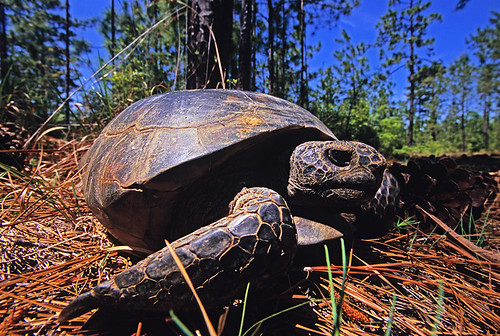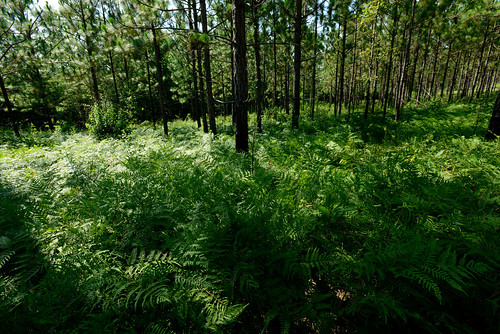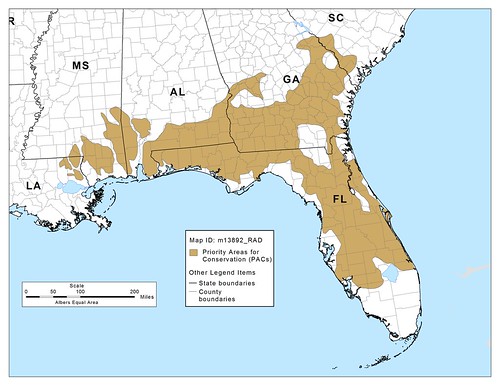
The gopher tortoise is the keystone species of longleaf pine forests as its burrows provide shelter to 360 other species.
The gopher tortoise earned its name for good reason – because it likes to dig and spends much of its time underground. The gopher tortoise, the Southeast’s only land-dwelling tortoise, burrows in the sandy soils below longleaf pine forests where it can escape heat and danger.
Its burrows are popular. About 360 other species, from rattlesnakes to rabbits, toads, and northern bobwhite take advantage of the underground real estate provided by the tortoise, what biologists call a keystone species because other species depend on it.
But the gopher tortoise has suffered population declines, parallel with the loss of its habitat, America’s longleaf pine forests. Longleaf pine forests once stretched from Texas to Virginia, but in the past two centuries their range has declined by almost 97 percent.

The biodiversity of longleaf pine forests, especially their lush forest floors, rivals the Amazon rainforest.
By restoring and better managing longleaf forests, landowners are stepping up to help the gopher tortoise. Here’s how landowners are voluntarily providing shell-ter for the gopher tortoise:
Use of prescribed fire: Landowners carefully burn forests, mimicking historic conditions where natural fire frequently swept through the landscape. Fire keeps woody competition in check within longleaf pine stands and promotes the growth of a lush understory, filled with an assortment of wildflowers and native grasses.
Managing brush: Fire is not the only way to promote the growth of a healthy understory. Invasive and undesired plants can be removed mechanically or using EPA-approved chemicals. This stimulates new plant growth, easy-to-reach for the gopher tortoise, which stands about a foot high.
Restoring forests: Landowners are planting new forests, helping expand the longleafs’ footprint back out to its original range.
Use of prescribed grazing: Livestock and longleaf can live in harmony. By preventing the overgrazing of pastures and using silvopasture (a practice where landowners produce trees and livestock in the same place), landowners are improving the health of the longleaf landscape.
Protecting forests: Landowners are taking advantage of conservation easement programs, receiving payment for their protection of key habitats.
USDA’s Natural Resources Conservation Service (NRCS) provides technical and financial assistance to landowners to help restore and better manage longleaf forests. Through this assistance, NRCS works with landowners to plan and implement conservation practices, and even covers part of the costs.
The U.S. Fish and Wildlife Service listed the gopher tortoise as threatened in the western part of its range in 1987, and it is now a candidate for listing in the remainder of its range. With 80 percent of gopher tortoise habitat falling on private lands, this voluntary work by landowners is critically important to conserving and recovering the species so that further regulation is not necessary. This work also benefits many other game and non-game species, including northern bobwhite, white-tailed deer and an assortment of migratory birds.
NRCS is focusing habitat restoration for the gopher tortoise through Working Lands for Wildlife(WLFW), the agency’s science-based effort to aid species in need. Because of the work of landowners through WLFW, species like the greater sage-grouse and New England cottontail are on the rebound. Since 2012, landowners have restored 278,000 acres of gopher tortoise habitat.
During the next two years, NRCS plans to work with landowners to restore, enhance and protect more than 200,000 additional acres, outlined in a new implementation strategy that the agency released in October. This strategy uses new priority areas for conservation, which were developed in concert with partnering agencies and non-government organizations to best align efforts and net the highest biological returns.
Landowners interested in receiving assistance to aid the gopher tortoise by restoring, enhancing and protecting longleaf forests should contact their local USDA service center.

Through Working Lands for Wildlife, NRCS is focusing habitat restoration efforts for the gopher tortoise in these priority areas for conservation.
No comments:
Post a Comment
Note: Only a member of this blog may post a comment.